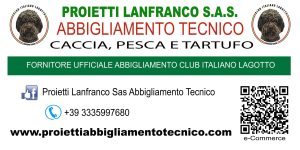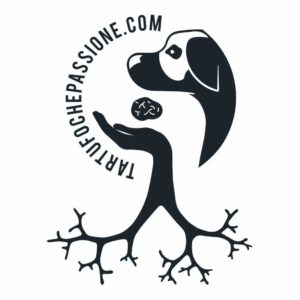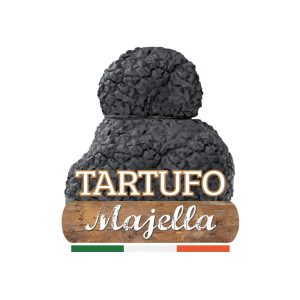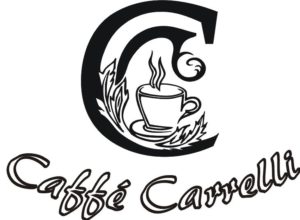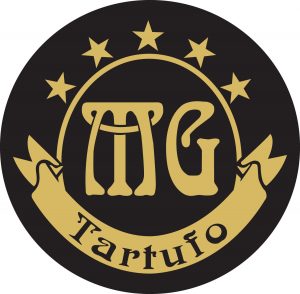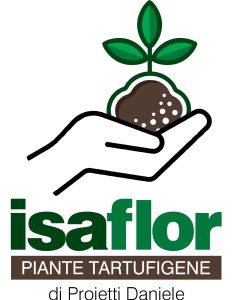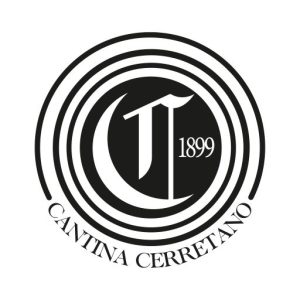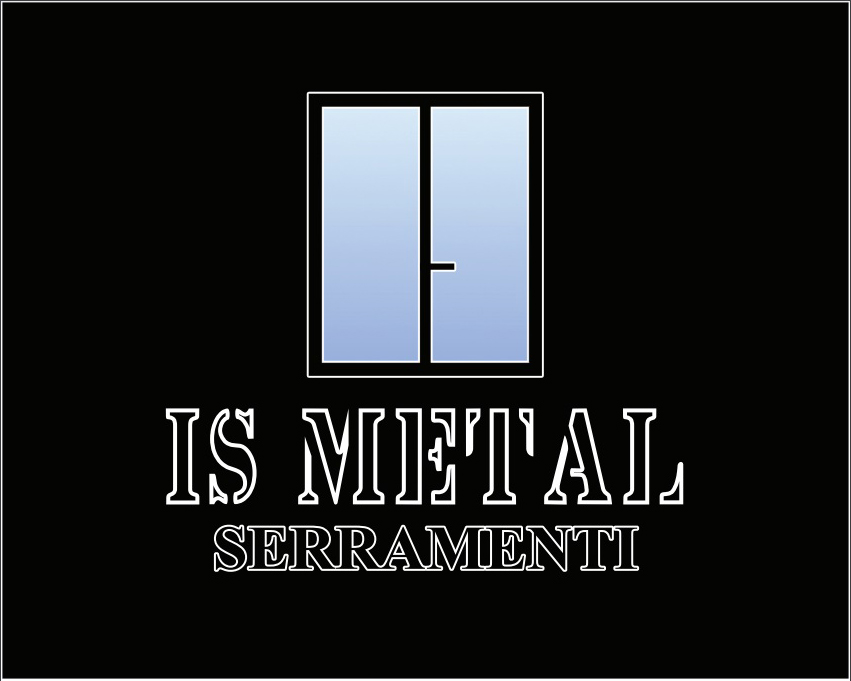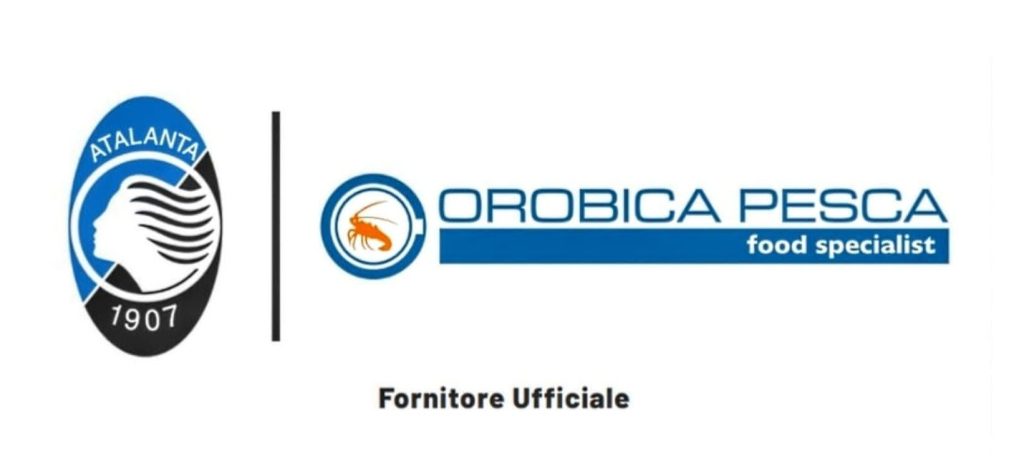>Commento allo standard >Standard originale
STANDARD DEL LAGOTTO ROMAGNOLO
Traduzione in italiano a cura del sig. Pietro Paolo Condo’
FCI Standard N° 298 – pubblicazione del 17.12.2015 – in vigore dal 1 gennaio 2016
LAGOTTO ROMAGNOLO
TRADUZIONE: Mrs. Renée Sporre-Willes. Rivisto da Renée Sporre-Willes.
Lingua ufficiale Inglese.
ORIGINE: Italia
DATA DI PUBBLICAZIONE DELLO STANDARD ORIGINALE VIGENTE: 17.12.2015
UTILIZZAZIONE: Cane da tartufo.
CLASSIFICAZIONE FCI:
Gruppo 8 Cane da riporto, da cerca, da acqua.
Sezione 3 cane da acqua.
Senza prova di lavoro
BREVI CENNI STORICI: Antica razza di cani da riporto in acqua nelle pianure di Comacchio e zone paludose di Ravenna. Nel corso dei secoli le vaste zone paludose furono risanate e divennero terreni arabili. Di conseguenza il Lagotto cambiò e da cane da acqua divenne un eccellente cane da tartufo nell’aperta campagna piatta e sulle colline della Romagna.
ASPETTO GENERALE: Cane di taglia da medio a piccola, ben proporzionato, potentemente costruito, di apparenza rustica, con un fitto mantello ricciuto di tessitura lanosa.
PROPORZIONI IMPORTANTI: Il cane è alto quasi come lungo (quasi nel quadrato). La lunghezza della testa è i 4/10 dell’altezza al garrese. La lunghezza del cranio dovrebbe essere leggermente superiore alla lunghezza del muso. La profondità del torace è inferiore al 50% (circa 44%) dell’altezza al garrese.
COMPORTAMENTO E CARATTERE: La sua attitudine naturale alla cerca e il suo ottimo olfatto fanno di questa razza un efficiente ricercatore di tartufi. L’istinto di caccia è stato modificato nel corso della selezione genetica, quindi il suo lavoro non risulta distratto dagli odori (di cacciagione). Il Lagotto è docile, poco esigente, attento, affettuoso, molto attaccato al suo padrone e facile da addestrare. Egli è anche un ottimo compagno e un ottimo cane da guardia.
TESTA : Vista dall’alto ha forma trapezoidale ed è moderatamente ampia; gli assi longitudinali superiori del cranio e del muso sono leggermente divergenti.
– REGIONE CRANICA
Cranio largo alle arcate zigomatiche, e lungo quanto largo. Visto di lato, dall’occipite allo stop, il cranio dovrebbe essere più lungo del muso. È leggermente convesso e tende ad appiattirsi verso l’occipite. Seni frontali ben sviluppati, arcate sopraccigliari marcate, solco medio-frontale pronunciato, cresta occipitale corta e non molto sviluppata, fosse sopraorbitali leggermente marcate.
Stop: Non troppo pronunciato, ma evidente.
– REGIONE FACCIALE:
Tartufo: Voluminoso, con narici aperte e mobili. Scanalatura mediana fortemente pronunciata. Visto di lato, il tartufo prosegue sullo stesso livello del muso e sporge molto leggermente dalla faccia anteriore delle labbra. Il colore va dal marrone chiaro al marrone scuro, in armonia col colore del mantello.
Muso: Piuttosto ampio, un po’ più corto del cranio, la sua altezza è solo leggermente inferiore alla lunghezza. Ha una forma leggermente a cuneo, con una faccia anteriore moderatamente piatta. La canna nasale ha un profilo rettilineo.
Labbra: Le labbra non sono troppo spesse, sono piuttosto tese, così che il profilo inferiore del muso è determinato dalla mandibola. Sono ricoperte da baffi lunghi e piuttosto ispidi. Viste dal davanti le labbra formano un ampio semicerchio. Il colore dei bordi labiali va dal marrone chiaro al marrone scuro.
Mascelle/Denti: Mascelle forti con branche piuttosto diritte e un corpo mandibolare relativamente largo. Chiusura completa a forbice o a tenaglia con denti bianchi e ben sviluppati. Leggero prognatismo inferiore accettabile.
Guance: Piatte.
Occhi: Grandi, ma mai esagerati, arrotondati, che ben riempiono le orbite, ben distanziati. Il colore dell’iride va dall’ocra al nocciola e marrone scuro, secondo il colore del mantello. Palpebre strettamente aderenti; il colore dei bordi palpebrali va dal marrone chiaro al marrone scuro. Ciglia molto ben sviluppate. Sguardo attento, espressione intelligente e vivace.
Orecchie : Di dimensione media proporzionata alla testa, forma triangolare con punte arrotondate; la loro base è piuttosto ampia; sono inseriti appena al di sopra dell’arcata zigomatica. Pendenti a riposo o leggermente rialzati quando il cane è in attenzione. Se tirati verso il tartufo dovrebbero raggiungere il muso a 1⁄4 della sua lunghezza. Anche la parte interna del padiglione è ricoperta di pelo.
COLLO: Forte, muscoloso, asciutto, di sezione ovale; ben distinto dalla nuca e assolutamente privo di giogaia, leggermente arcuato. Nei maschi il perimetro del collo può raggiungere il doppio della sua lunghezza. La lunghezza del collo è leggermente inferiore alla lunghezza totale della testa.
TRONCO: Compatto e forte; lungo quanto l’altezza al garrese.
Linea superiore: Diritta dal garrese alla groppa.
Garrese: E’ più alto del livello della groppa; le scapole nel loro punto più alto non sono troppo ravvicinate, ma ben salienti ed estese all’indietro.
Dorso: Rettilineo, molto muscoloso.
Rene: Corto, molto solido, visto di profilo leggermente arcuato. La sua larghezza è uguale o supera leggermente la sua lunghezza.
Groppa: Lunga, ampia, muscolosa, leggermente obliqua.
Torace: Ben sviluppato discende fino ai gomiti. Sebbene sia piuttosto stretto di fronte, si allarga caudalmente a partire dalla sesta costola.
Linea inferiore: Lunga sezione sternale a forma di linea retta; risale leggermente in direzione caudale.
CODA: Inserita non troppo alta né troppo bassa; si assottiglia verso l’estremità. Quando è pendente, dovrebbe giusto arrivare al garretto. La coda è ricoperta di pelo lanoso e ispido. A riposo è portata a scimitarra; in attenzione decisamente rialzata. Al lavoro, o quando il cane è eccitato può essere portata sul dorso, ma mai arrotolata.
ARTI ANTERIORI:
Aspetto generale: Regolari, verticali, sia visti di fronte che di lato.
Spalla: Scapole lunghe, ben angolate all’indietro (52-55°), muscolose, forti e strettamente aderenti al torace, ma con libertà di movimento.
Braccio: Muscoloso, di ossatura sottile, lungo come la scapola; la sua inclinazione sull’orizzontale va da 58-60°.
Gomito: Bene aderente alla parete toracica, ma non troppo strettamente; ricoperto da pelle sottile; parallelo al piano sagittale del tronco come le braccia. La punta del gomito è posizionata sulla linea verticale che scende dall’angolo posteriore della scapola al suolo.
Avambraccio: Perfettamente verticale, lungo, con ossa compatte e forti a sezione ovale.
Carpo (Polso): Visto dal davanti è in linea verticale con il braccio; fine, robusto e mobile; osso pisiforme marcatamente sporgente.
Metacarpo (Pasturali): Piuttosto meno spesso e dall’ossatura più fine dell’avambraccio, mobile e resistente; visto di profilo forma un angolo di 75° a 80° col suolo.
Piedi anteriori: Leggermente arrotondati, compatti, con dita arcuate e chiuse. Unghie forti e ricurve. Cuscinetti ben pigmentati. Membrane interdigitali molto ben sviluppate.
ARTI POSTERIORI:
Aspetto generale: Potenti, verticali visti dal di dietro, ben proporzionati al formato del cane e paralleli.
Coscia: Lunga con muscoli ben definiti ed evidenti. L’asse del femore ha una inclinazione di 80° sulla linea orizzontale. La coscia è parallela al piano mediano del corpo.
Ginocchio: L’angolo del ginocchio varia da 130° a 135.
Gamba: Leggermente più lunga della coscia con buona ossatura e muscolatura, con marcata scanalatura muscolare. La sua inclinazione sull’orizzontale va da 50° a 55°. La direzione è parallela al piano mediano del corpo.
Garretto: Ampio, spesso, asciutto, con salienze ossee nettamente delineate e ben angolato.
Metatarso: Sottile, cilindrico, perpendicolare al suolo. Senza speroni.
Piedi posteriori: Leggermente più ovali di quelli anteriori e con dita leggermente meno arcuate.
ANDATURA: Passo regolare, trotto energico e vivace, galoppo per brevi periodi.
PELLE: Sottile, strettamente aderente a tutto il corpo, senza rughe. Il pigmento delle mucose e dei cuscinetti va dal marrone chiaro al marrone molto scuro.
MANTELLO:
Pelo: Di tessitura lanosa, mai contorto a formate cordature sottili, semiruvido in superficie, forma stretti riccioli, a forma di anello, con evidente sottopelo. I riccioli devono essere distribuiti uniformemente su tutto il corpo e la coda tranne che sulla testa, dove i riccioli sono meno chiusi e formano abbondanti sopracciglia, baffi e barba. Anche le guance sono ricoperte di fitto pelo. Sulle orecchie, il pelo tende a mostrare riccioli meno chiusi, ma rimane molto ondulato. Non presenta pelo corto sulle orecchie. Il mantello esterno e specialmente il sottopelo sono impermeabili.
Se non viene tagliato, il pelo tende ad infeltrirsi (durante la crescita); quindi un taglio completo deve essere fatto almeno una volta l’anno. Il pelo ed il sottopelo che si sono infeltriti devono essere periodicamente rimossi. Il taglio del pelo non deve essere più lungo di circa 4 cm e dovrebbe essere uniforme con la sagoma del cane. Solo sulla testa il mantello può essere più lungo, ma non così lungo da coprire gli occhi. L’area intorno ai genitali e l’ano dovrebbero avere il pelo tagliato corto. Il mantello non deve essere modellato e spazzolato come nei Barboni e nei Bichon Frisé o tagliato corto tale da impedire l’arricciatura o la valutazione della tessitura. Qualsiasi toelettatura eccessiva escluderà il cane dall’essere qualificato. La corretta toelettatura è non eccessiva e contribuisce ad accentuare il naturale aspetto rustico tipico della razza.
Colore: Monocolore bianco sporco, bianco con macchie marroni o arancio, roano arancione, roano marrone, marrone monocolore (in diverse tonalità) con o senza bianco, arancio con o senza bianco. Alcuni cani hanno una maschera da marrone a marrone scuro. Le focature (nelle diverse tonalità) sono permesse.
TAGLIA E PESO
Altezza al garrese:
Maschi da 43 a 48 cm. (altezza ideale: 46 cm)
Femmine da 41 a 46 cm. ( altezza ideale: 43 cm)
Tolleranza di 1 cm. in più o in meno
Peso: Maschi da 13 a 16 kg. Femmine da 11 a 14 kg.
DIFETTI: Qualsiasi deviazione da quanto sopra deve essere considerato un difetto e deve essere penalizzato in proporzione alla sua gravità ed al suo effetto sulla salute e sul benessere del cane e sulla sua capacità di svolgere il suo lavoro tradizionale.
DIFETTI DA SQUALIFICA:
- Soggetti aggressivi o estremamente timidi.
- Ogni cane che presenta chiaramente anormalità fisiche o comportamentali deve essere squalificato.
- Soggetti non tipici.
- Assi cranio muso convergenti.
- Depigmentazioni parziali o totali.
- Canna nasale concava.
- Enognatismo e prognatismo pronunciato.
- Strabismo.
- Coda portata sul dorso; anurismo o coda corta congenito o artificiale.
- Coda amputata.
- Pelo non arricciato o tagliato troppo corto.
- Pelo cordato.
- Eccesso di toelettatura.
- Colore nero del mantello, macchie nere o pigmentazioni nere.
- Fuoritaglia (soprataglia, sottotaglia).
N.B.: I maschi devono avere due testicoli d’aspetto normale completamente discesi nello scroto. Solo quei soggetti funzionali, clinicamente sani e tipici, dovrebbero essere adibiti alla riproduzi
STANDARD DEL LAGOTTO ROMAGNOLO TESTO UFFICIALE F.C.I.
FCI-Standard N° 298
ROMAGNA WATER DOG
(Lagotto Romagnolo)
TRANSLATION: Antonio Morsiani, Renée Sporre-Willes, Dr. J.-M. Paschoud and Prof. R. Triquet. Revised by ENCI and Renée Sporre-Willes / Original version : (FR).
ORIGIN: Italy.
DATE OF PUBLICATION OF THE OFFICIAL VALID STANDARD: 13.11.2015.
UTILIZATION: Truffle dog.
FCI-CLASSIFICATION: Group 8 Retrievers – Flushing Dogs
– Water Dogs.
Section 3 Water Dogs.
Without working trial.
BRIEF HISTORICAL SUMMARY: Ancient breed of retrieving water dogs in the lowlands of Comacchio and the marshlands of Ravenna. During the centuries, the great marshlands were drained and turned into arable land. Subsequently the Lagotto changed from being a water dog to an excellent dog for searching truffles in the flat open country and in the hills of Romagna.
GENERAL APPEARANCE: Small to medium-sized dog, well proportioned, powerfully built, of a rustic appearance, with a dense, curly coat of woolly texture.
IMPORTANT PROPORTIONS: The dog is nearly as high as long (nearly square). The length of the head is 4/10 of the height at the withers. The length of the skull should be slightly more than the length of the muzzle. The depth of the chest is less than 50 % (about 44 %) of the height at the withers.
BEHAVIOUR/TEMPERAMENT: A natural gift for searching and its very good nose has made the breed very efficient in truffle searching. The former hunting instinct has been modified by genetic selection; hence his work is not distracted by the scent of game. The Lagotto is tractable, undemanding, keen, affectionate, very attached to his owner and easy to train. He is also a very good companion and an excellent watchdog.
HEAD: Viewed from above, trapezoidal in shape and moderately broad; the upper longitudinal axes of the skull and the muzzle diverge slightly.
CRANIAL REGION
Skull: Broad at the level of the zygomatic arches, and as long as it is broad. Viewed from the side, from occiput to stop, the skull should be longer than the muzzle. It is slightly convex and tends to flatten out at the back of the skull. Frontal sinuses well developed, brows marked, the medio-frontal furrow pronounced, occipital crest short and not very developed, supraorbital fossae slightly marked.
Stop: Not too pronounced, but evident.
FACIAL REGION
Nose: Large with nostrils wide open and mobile. Median groove strongly pronounced. Viewed in profile, the nose continues on the same level as the muzzle and protrudes very slightly from the front edge of the lips. The colour ranges from light to dark brown, depending on the colour of the coat.
Muzzle: Fairly broad, a little shorter than the skull, it’s depth being only slightly less than the length. Muzzle is slightly wedge shaped and giving a rather blunt profile. The nasal bridge has a straight profile. Lips: The lips are not too thick; they are rather tight, so that the mandible determines the lower profile of the muzzle. Lips are covered with a long and rather bristly moustache. Viewed from the front, the lips form a wide semi-circle. The colour of the lip-rims ranges from light to dark brown.
Jaws/Teeth: Jaws strong with almost straight branches and a relatively spacious mandibular body. Scissor or pincer bite with complete white and well-developed teeth. Slightly reverse scissors bite acceptable.
Cheeks: Flat. Eyes: Large, but never exaggerated, rounded in shape filling the socket and set fairly well apart. The colour of the iris ranges from ochre to hazel and dark brown depending on the colour of the coat. Eyelids are close fitting and the colour of the eye-rims ranges from light to dark brown. Eyelashes very well developed. Look alert, expression keen and lively.
Ears: Medium-sized in proportion to the head, triangular with rounded tips; their base is rather wide; they are set just above the zygomatic arches. Hanging at rest or slightly raised when the dog is attentive. If pulled towards the nose they should reach the muzzle at 1/4 of its length. The inner part of the auricle is also covered with hair.
NECK: Strong, muscular, lean, of oval cross section; well set off from the nape and absolutely free from dewlap, slightly arched. In males the perimeter of the neck can reach the double of its length. The length of the neck is a little less than the total length of the head.
BODY: Compact and strong, as long as the height at the withers.
Topline: Straight from the withers to the croup.
Withers: They rise above the level of the croup; the highest points of the shoulder blades are not too close, but quite high set and well laid back.
Back: Straight, very muscular.
Loin: Short coupled, very strong, in profile slightly convex. Width is equal or slightly exceeds the length.
Croup: Long, wide, muscular, slightly sloping.
Chest: Well developed, reaching down to the elbows. Although fairly narrow in front, from the sixth rib the chest widens towards the back.
Underline and belly: Long sternal section in form of a straight line; the following tuck-up is only slight.
TAIL: Set on neither too high nor too low tapering towards the end. When hanging, it should barely reach the hocks. The tail is covered with woolly and rather bristly hair. At rest carried scimitar like; when attentive decidedly raised. When working or excited can be carried over the back, but never curled.
LIMBS
FOREQUARTERS
General Appearance: Regular, upright seen from the front and in profile.
Shoulder: Shoulder blades long, well laid back (52°–55°), muscular, strong and closely attached to the chest, but moving freely.
Upper arm: Muscular, of thin bone structure, as long as the shoulder blade; its inclination to the horizontal ranges from 58°– 60°.
Elbow: Well attached to the chest wall, but not too tightly; covered with thin skin; parallel to the median sagittal plane of the body as are the upper arms. The tip of the elbow is located on a vertical line lowered from the back end of the scapula to the ground.
Forearm: Perfectly vertical, long, with compact, strong bone of oval cross-section.
Carpus (Wrist): Viewed from the front in a vertical line with the forearm; fine, robust and mobile; pisiform bone markedly protruding.
Metacarpus (Pastern): Rather less thick and of finer bone compared with the forearm, it’s fine and resilient. Seen in profile, it forms an angle of 75°–80° to the ground.
Forefeet: Slightly rounded, compact, with arched and tight toes. Nails strong and curved. Pads well pigmented. Inter-digital membranes very well developed.
HINDQUARTERS
General Appearance: Powerful, upright seen from the rear, well proportioned to the size of the dog and parallel.
Thigh: Long, with clearly defined and visible muscles. The axis of the femur has a distinct inclination of 80° to the horizontal. The thigh is parallel to the median plane of the body.
Stifle(Knee): The angle of the stifle ranges from 130°–135°. Lower thigh: Slightly longer than the thigh, well boned and muscled, with marked muscular groove. Its inclination to the horizontal ranges from 50° to 55°. Its direction is parallel to the median plane of body.
Hock joint: Broad, thick, lean, with clear-cut bone and well angulated.
Metatarsus (Rear Pastern): Thin, cylindrical, perpendicular to the ground. No dewclaws. Hind feet: Slightly more oval-shaped than forefeet and toes slightly less arched.
GAIT / MOVEMENT: Walk is regular; trot is energetic and brisk, gallop for short periods.
SKIN: Thin, close fitting all over the body, without wrinkles. Pigmentation of the skin connecting with mucous membranes and of pads ranges from light to dark and very dark brown.
COAT
Hair: Of woolly texture, never twisted to form thin cords, semirough on the surface, with tight, ring shaped curls, with visible undercoat. Curls must be evenly distributed all over the body and tail, except on the head, where the curls are not as tight forming, abundant eyebrows, whiskers and beard. Even the cheeks are covered with thick hair. On the ears, the hair tends to show looser curls, but remains very wavy. No short hair on the ears. The topcoat and especially the undercoat is water-proof. If not clipped, the hair tends to become felted (as it continuous to grow); therefore a complete clipping must be performed at least once a year. Felted topcoat and undercoat must be removed periodically. The clipped coat must not be thicker than max four centimetres and it should be uniform with the silhouette of the dog. Only on the head the coat can be longer, but not as long as to cover the eyes. The area around the genitals and anus should be clipped short. The coat must not be formed and brushed up in the fashion of the Poodles and Bichon frisé breeds or clipped short preventing it from curling or assessment of texture. Any excessive hair styling will exclude the dog from being qualified. The correct clip is un-pretentious and contributes to accentuate the natural, rustic look typical of the breed.
Colour: Off-white solid colour, white with brown or orange patches, orange roan, brown roan, brown (in different shades) with or without white, orange with or without white. Some dogs have a brown to dark brown mask. Tan markings (in different shades) allowed.
SIZE AND WEIGHT
Height at the withers:
Males: 43– 48 cm (ideal height: 46 cm).
Females: 41– 46 cm (ideal height: 43 cm).
Tolerance of 1 cm over or under.
Weight: Males: 13 – 16 kg.
Females: 11 – 14 kg. FAULTS:
Any departure from the foregoing points should be considered a fault and the seriousness with which the fault should be regarded should be in exact proportion to its degree and its effect upon the health and welfare of the dog and on its ability to perform its traditional work.
DISQUALIFYING FAULTS:
- Aggressive or overly shy dogs.
- Any dog clearly showing physical or behavioural abnormalities shall be disqualified.
- Untypical specimen.
- Axes of the skull and the muzzle converging.
- Partial and/or total de-pigmentation.
- Dish-faced.
- Overshot bite.
- Pronounced undershot bite.
- Wall-eye.
- Tail carried over the back; anury or short tail, whether congenital or artificial.
- Docked tail.
- Coat not curled or clipped too short.
- Corded coat.
- Sculptured clip.
- Black coat colour, black patches or black pigmentation.
- Oversize or undersize.
N.B.:
- Male animals should have two apparently normal testicles fully descended into the scrotum.
- Only functionally and clinically healthy dogs, with breed typical conformation should be used for breeding.


